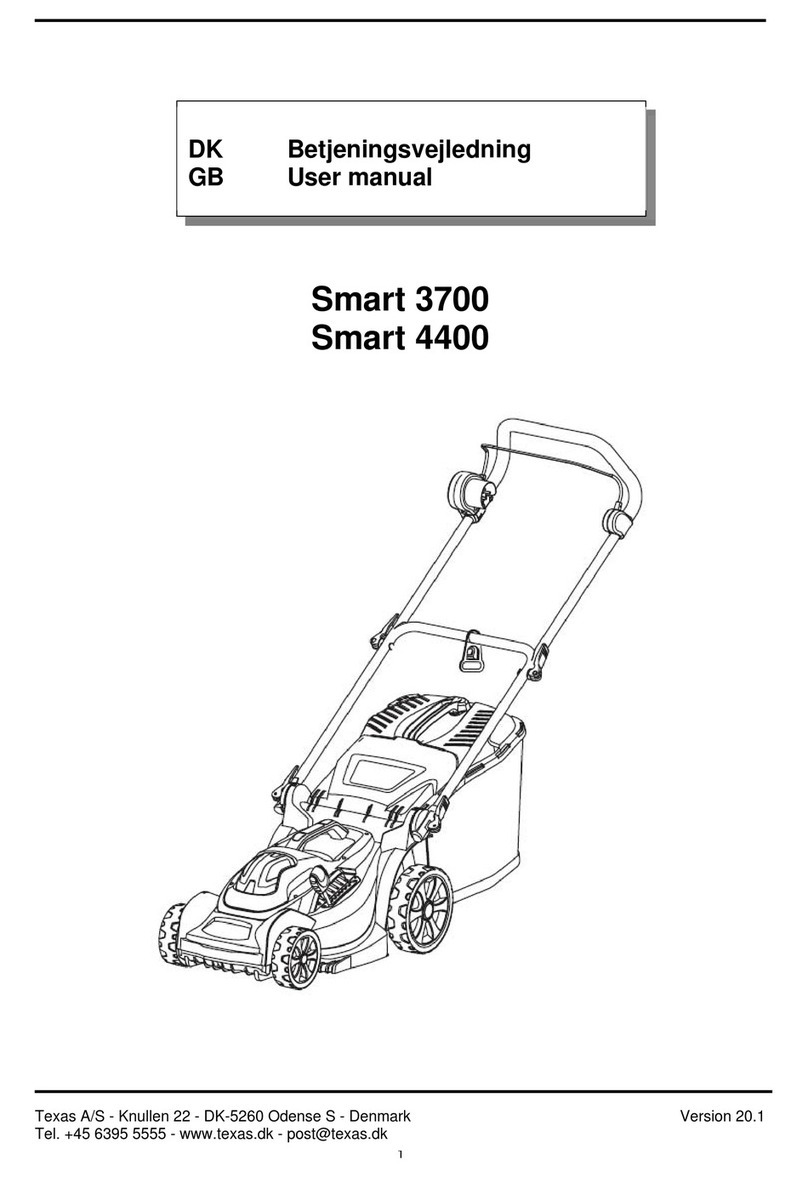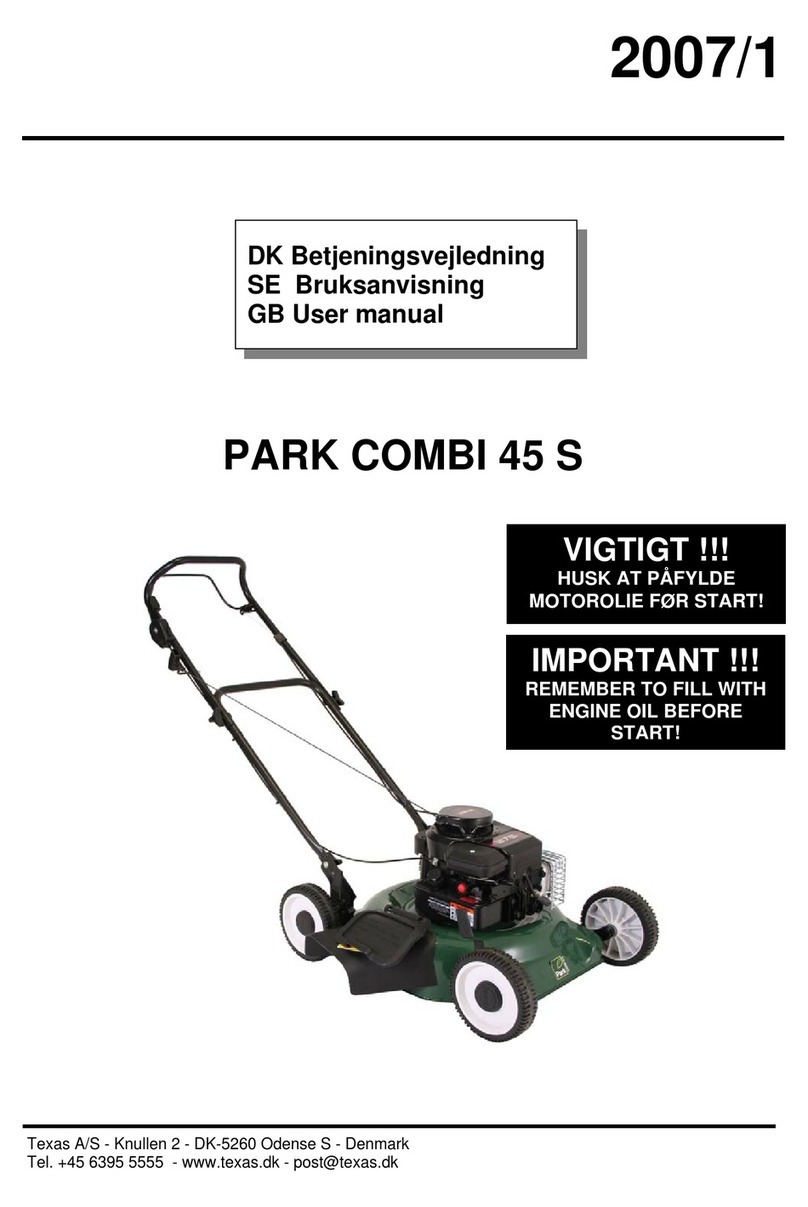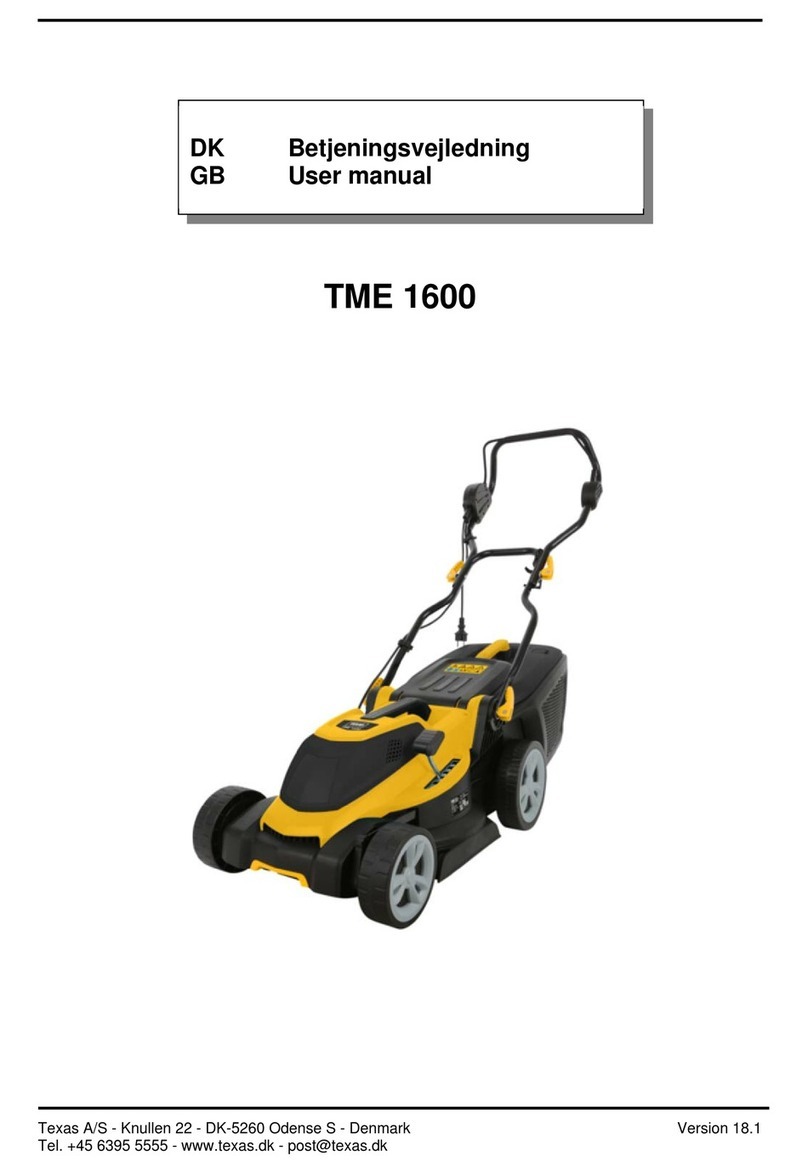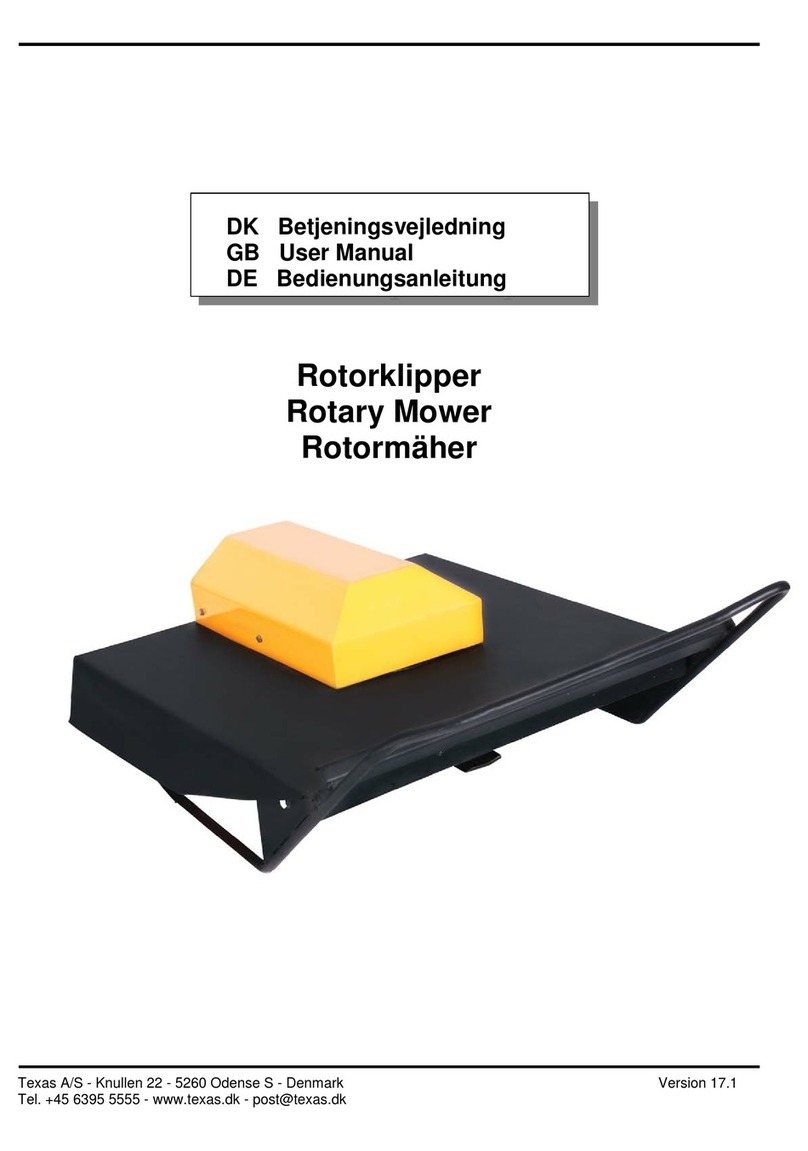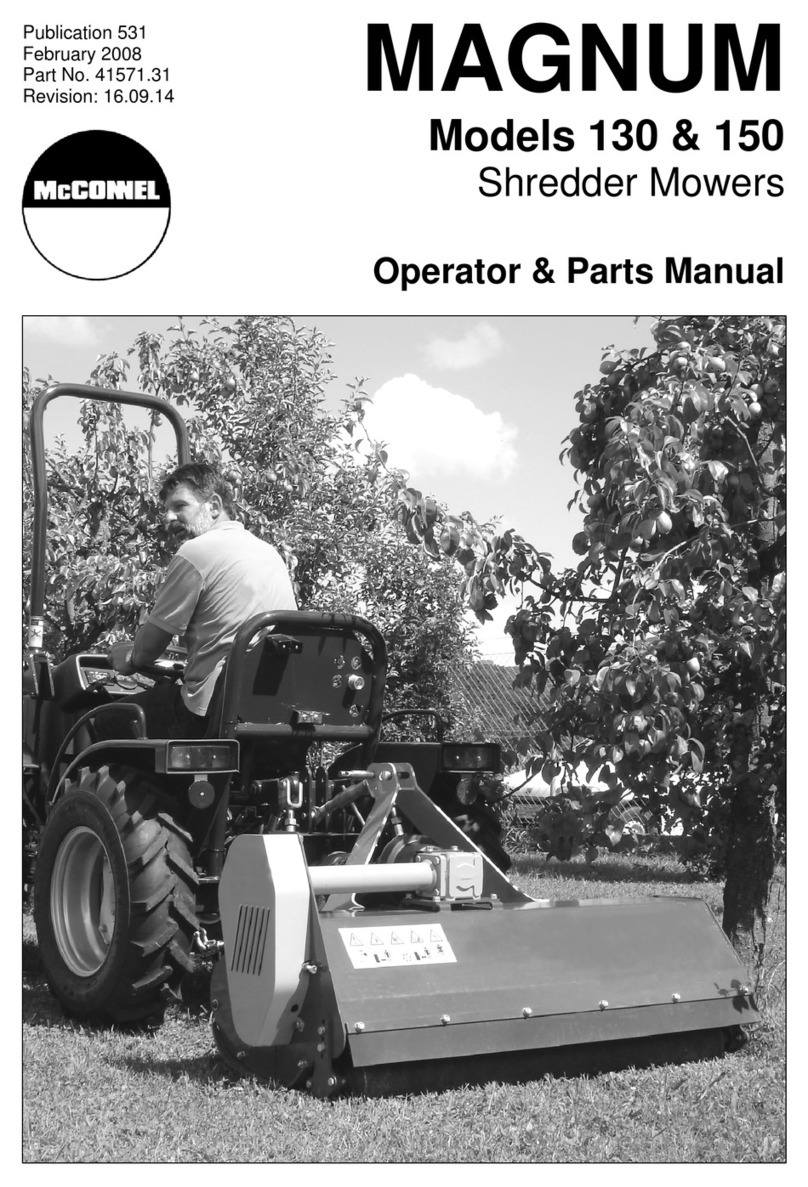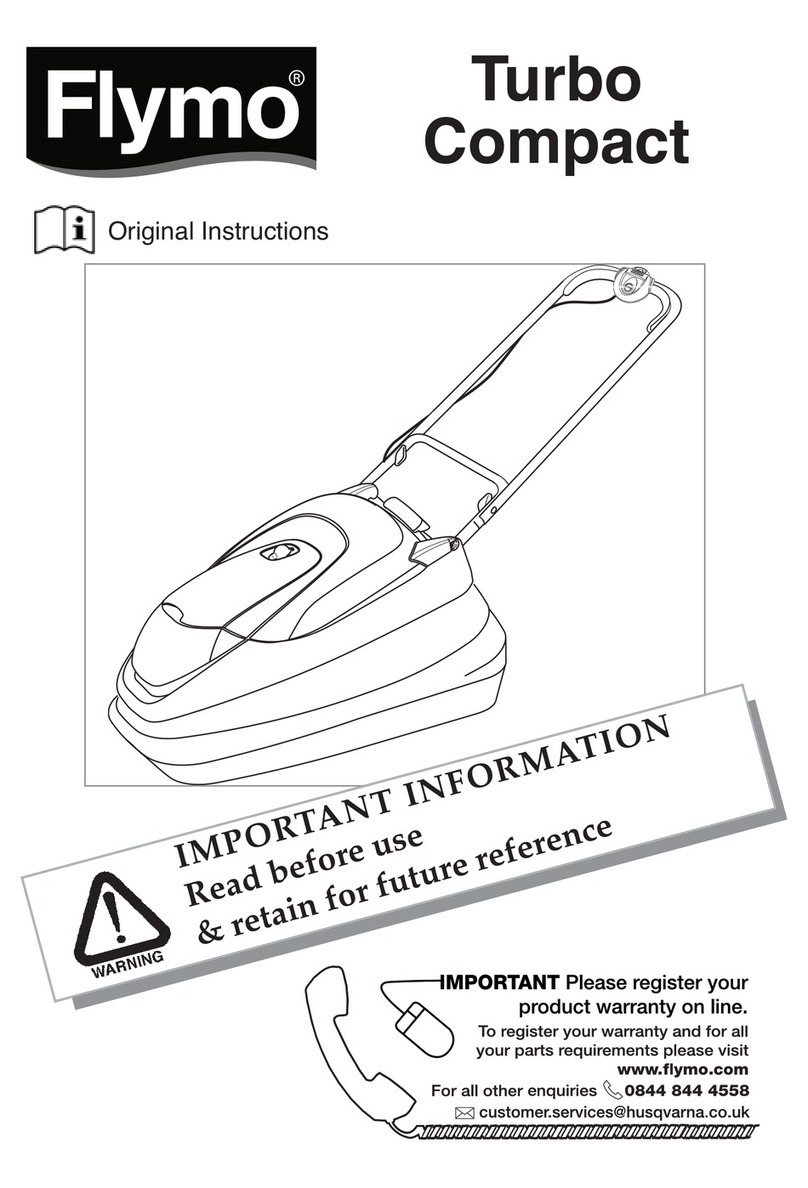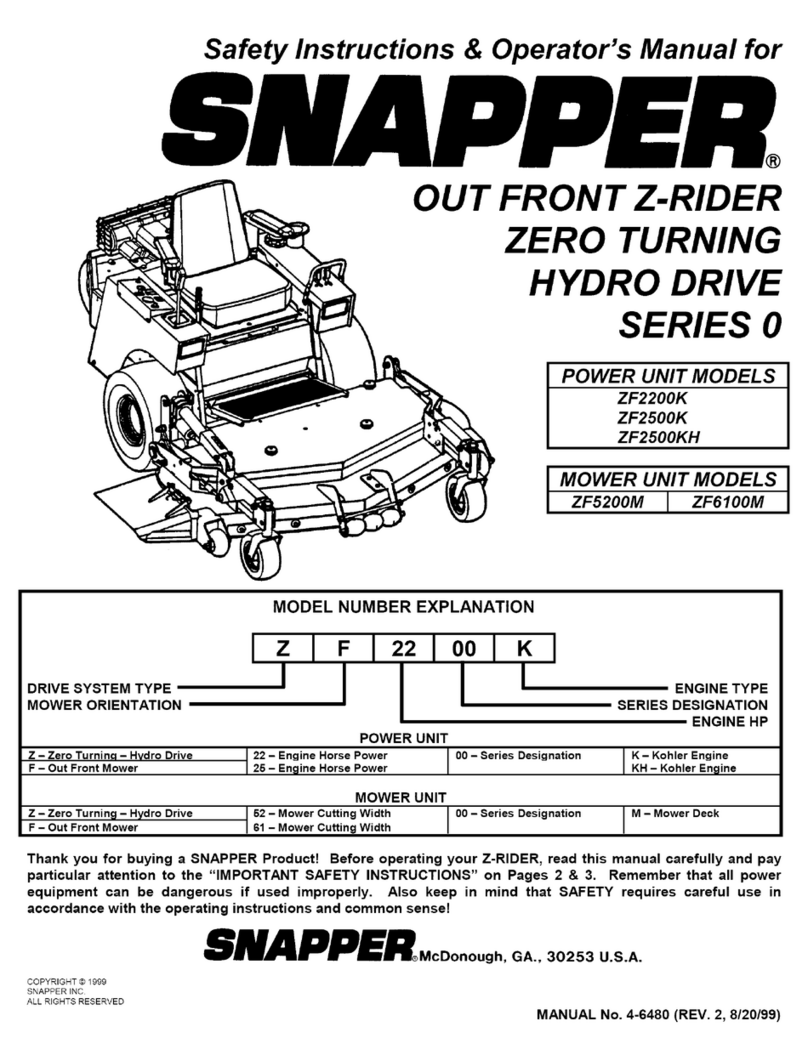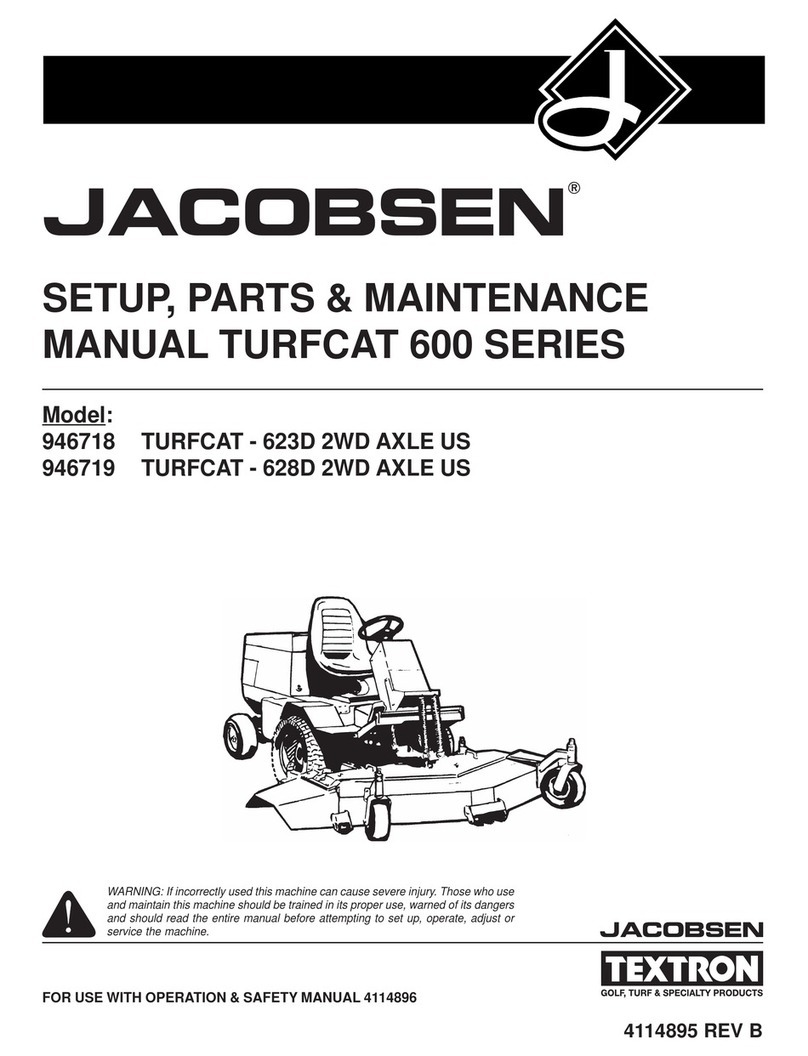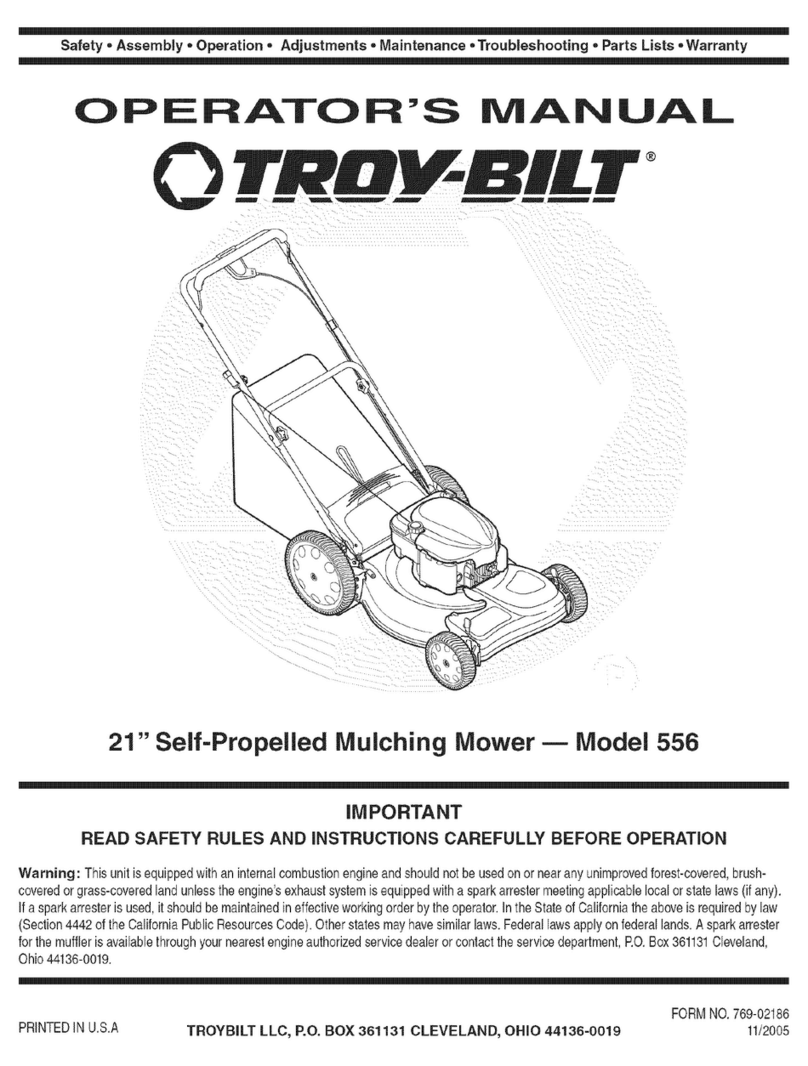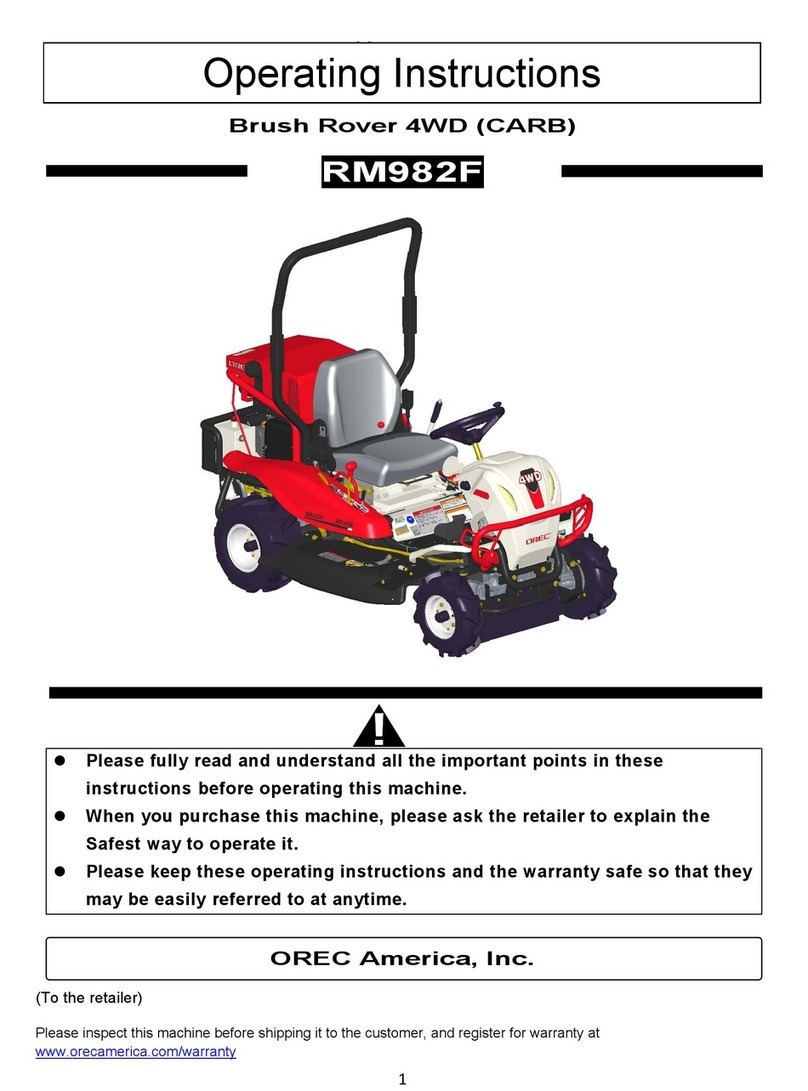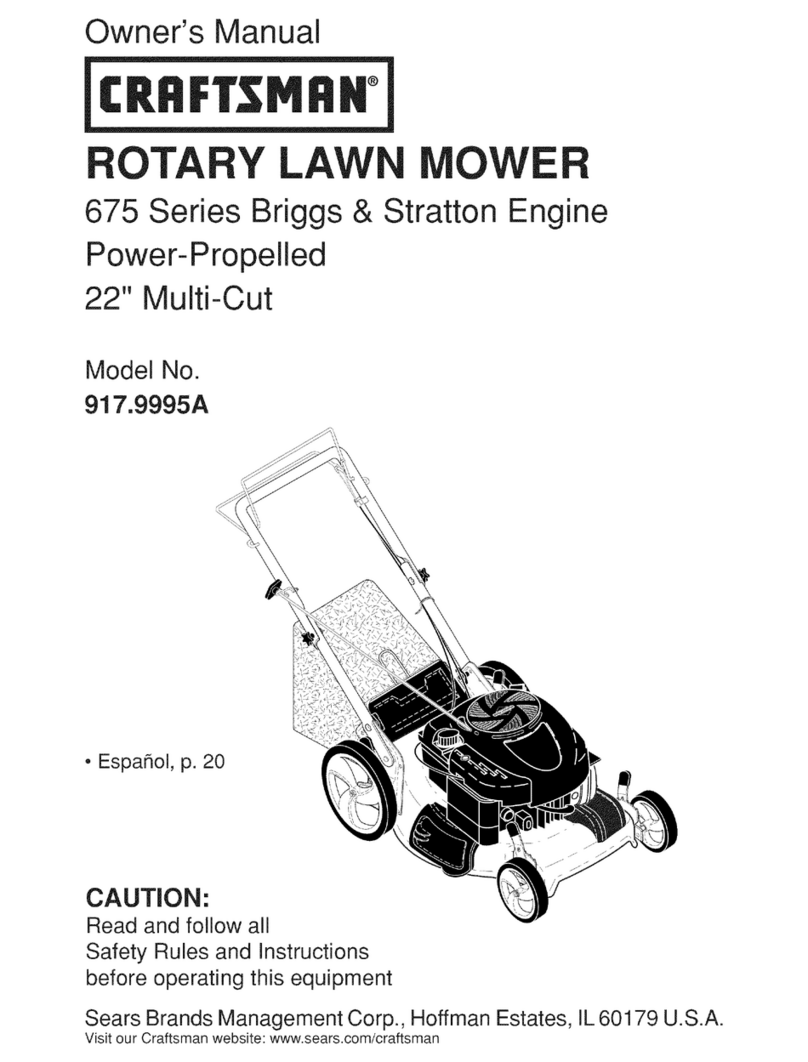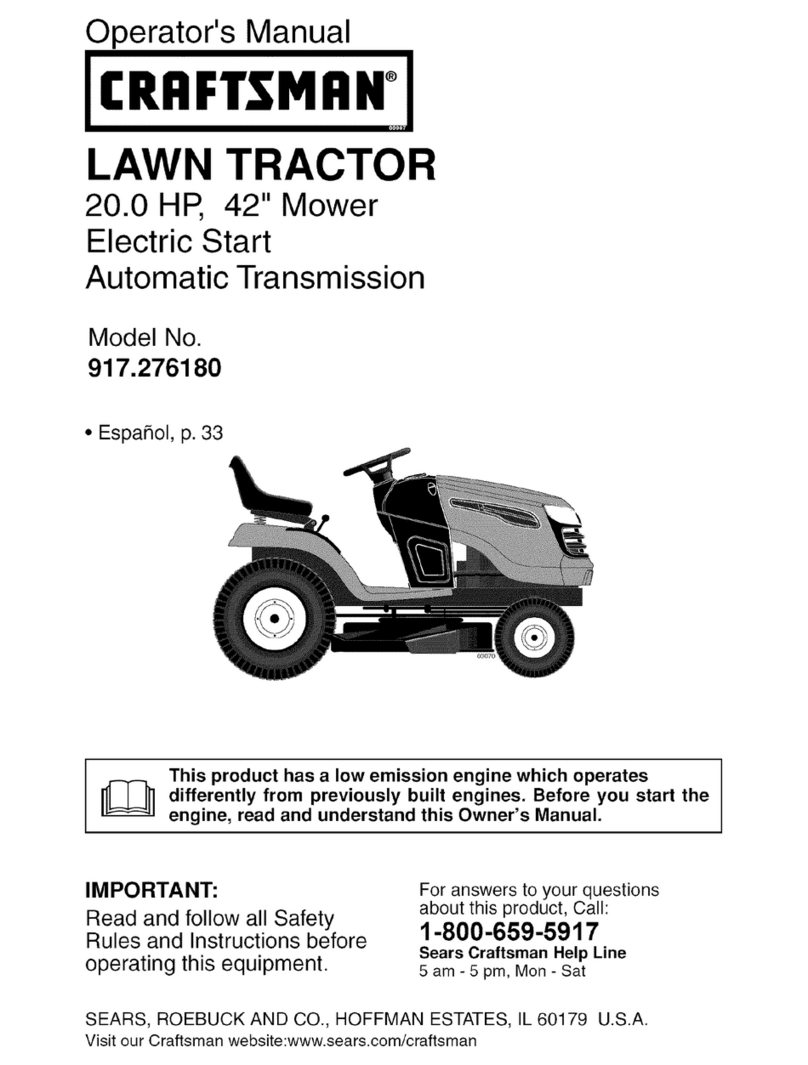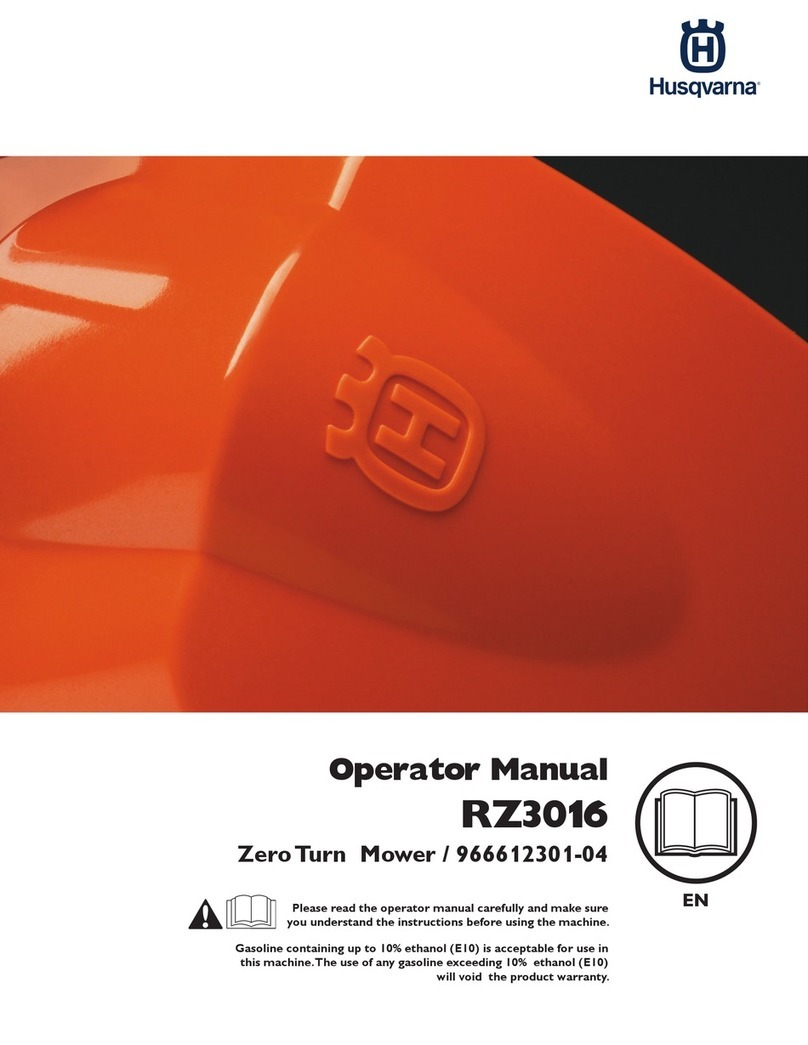Texas Andreas Petersen XC160-108H User manual

Original instructions
TEXAS XC160-108H
OWNER’S MANUAL
WARNING!
Read this manual carefully before using the machine
Texas A/S - Knullen 22 - DK-5260 Odense S - Denmark Version 18.1

INTRODUCTION
1
INTRODUCTION
Dear Customer,
Thank you for having chosen one of our products. We hope that you
will get complete satisfaction from using your new machine and that it will
fully meet all your expectations.
This manual has been written to help you become familiar with the
machine and use it safely and efficiently. Do not forget that it is an
integral part of the machine, so keep it close at hand for future reference
and pass it on to the purchaser if you sell the machine.
This new lawn mower has been designed and built in compliance
with current standards, and is safe and reliable if used for cutting and
collecting grass following the instructions given in this manual (proper
usage). If you use the machine in any other way or ignore the
instructions for safe use, maintenance and repair, it is considered
"incorrect usage". In this case, the warranty is automatically voided and
the manufacturer is not held responsible for damage or injury to oneself
or others.
Since we regular improve our products, you may find slight
differences between your machine and the descriptions contained in this
manual. Modifications can be made to the machine without notice and
without the obligation to update the manual, although the essential safety
and function characteristics will remain unaltered. If in doubt, do not
hesitate to contact your dealer. And now enjoy your work!
AFTER-SALES SERVICE
This manual gives all the necessary instructions for using the
machine and carrying out basic maintenance.
Any adjustments or maintenance operations not described in
this manual must be carried out by your Dealer or a specialized
Service Centre. Both have the necessary knowledge and equipment
to ensure that the work is done correctly without affecting the safety
of the machine.
This will help you keep your new purchase in peak performance and
maintain its value over time.

INTRODUCTION
2
IMPORTANT
The lawnmower must always be used with utmost caution. So that
safety precautions and operating instructions are always readily on hand,
labels have been affixed to the machine showing pictographs illustrating
the main operating precautions
Because these labels, according to applicable safety standards, are
considered an integral part of the machine, the user is therefore
responsible for replacing them in the event of their becoming detached or
illegible.
For any replacement, contact your dealer.

INTRODUCTION
3
LABEL POSITION

TABLE OF CONTENTS
1
TABLE OF CONTENTS
1. SAFETY..............................................................................................1
2. IDENTIFICATION OF THE MACHINE AND COMPONENTS
.....................7
3. UNPACKING AND ASSEMBLY..........................................................8
4. CONTROLS AND INSTRUMENTS...................................................13
5. HOW TO USE THE MACHINE..........................................................16
5.1 SAFETY RECOMMENDATIONS.............................................16
5.2 WHY THE SAFETY DEVICES CUT IN....................................16
5.3 DIRECTIONS BEFORE STARTING WORK............................17
5.4 USING THE MACHINE............................................................18
5.5 USING ON SLOPING GROUND..............................................22
5.6 TRANSPORTING.....................................................................23
5.7 LAWN MAINTENANCE............................................................23
6. MAINTENANCE................................................................................25
6.1 SAFETY RECOMMENDATIONS.............................................25
6.2 SCHEDULED MAINTENANCE................................................25
6.3 CHECKS AND ADJUSTMENTS..............................................27
6.4 DISMANTLING AND REPLACEMENT.....................................28
6.5 LUBRICATION .........................................................................30
7. SPECIFICATIONS ............................................................................31

SAFETY
1
1. SAFETY
1.1 HOW TO READ THE MANUAL
Some paragraphs in the manual containing important information
regarding safety and operation are emphasized in the following ways.
NOTE or IMPORTANT These give details or further information on
what has already been said, in the aim to prevent damage to the
machine. Non-observance will result in the risk of injury to
oneself or others.
Non-observance will result in the risk of serious
injury or death to oneself or others.
This manual describes various versions of the machine
Positions on the machine, such as “front”, “back”, “left”
or “right” hand side, refer to the direction of
forward travel For all operations regarding
the use and maintenance of
the engine not described in this manual, refer
to the relevant manuals which form an integral
part of all the documentation supplied with the
machine.
1.2 GENERAL SAFETY REGULATIONS
Read carefully before using the machine.
A) TRAINING
1) Read the instructions carefully. Be familiar with the controls and
how to use the equipment properly.
2) Never let children or people unfamiliar with these instructions use
the machine. Local regulations can restrict the age of the user.
3) Never mow while people, especially children, or
pets nearby; Never mow while dark.
4) Keep in mind that the operator or user is responsible
for accidents or hazards occurring to other people or their property.

SAFETY
2
5) Do not carry passengers.
6) All drivers should seek and obtain professional and practical
instruction. Such instruction should emphasize:
– the need for care and concentration when working with ride-on
machines;
– you can not use the brake to regain control of a ride-on machine
sliding down a slope. The main reasons for loss of control are:
– insufficient wheel grip;
– overspeeding;
– inadequate braking;
– the type of machine is unsuitable for its task;
– unawareness of the effect of ground conditions, especially slopes;
– incorrect hitching and load distribution
B) PREPARATION
1) While mowing, always wear sturdy footwear
and long trousers. Do not operate the equipment
barefoot or wearing open sandals.
2) Thoroughly inspect the area where the equipment is to be used
and remove all objects which can be ejected from the machine.
3) DANGER! Petrol is highly flammable:
– store fuel in containers specifically designed for this
purpose;
– refuel outdoors only and do not smoke while refuelling;
–add fuel before starting the engine. Never remove the
cap of the fuel tank or add petrol while the engine is
running or when the engine is hot;
– if you spill petrol, do not start the engine and move the
machine away from the area of spillage. Do not create any source of
ignition until the petrol vapors have evaporated;
– put back and tighten all fuel tank and container caps securely.
4) Replace faulty silencers.
5) Before use, always inspect the machine to check that the blades,
blade bolts and cutter assembly are not worn or damaged. Replace worn
or damaged blades and bolts in sets to preserve balance.
6) On multi-bladed machines, remember that the rotation of one
blade can cause other blades to rotate

SAFETY
3
C) OPERATION 1) Do not start the engine in a confined space where
dangerous carbon monoxide fumes can collect.
2) Mow only in daylight or good artificial light.
3) Before starting the engine, disengage the blades and shift into
neutral.
4) Do not use the machine on lawns with gradients of more than
15°(27%);do not use the machine on lawns with side gradients
above 10°(18%).
5) Remember there is no such thing as a “safe” slope. Travelling
on grass slopes requires particular care. To guard against overturning:
– do not stop or start suddenly when going up or downhill;
– engage the drive slowly and always keep the machine in gear,
especially when travelling downhill;
– machine speeds should be kept low on slopes and during tight
turns;
– stay alert for humps and hollows and other hidden hazards;
–never mow across the face of the slope.
6) Use care when pulling loads or using heavy equipment:
– use only approved drawbar hitch points;
– limit loads to those you can safely control;
– do not turn sharply. Use care when reversing;
– use counterweight(s) or wheel weights whenever advised in the
instructions manual.
7) Stop the blades before crossing surfaces other than grass.
8) Never use the machine with damaged guards, or without the
safety protective devices in place.
9) Do not change the engine governor settings or overspeed the
engine. Operating the engine at excessive speed can increase the risk of
personal injury.
10) Before leaving the driving seat:
– disengage the blades and lower the attachments;
– go into neutral and apply the parking brake;
– stop the engine and remove the ignition key.
11) Disengage the blades, stop the engine and remove the
ignition key:
– before clearing blockages or unclogging the collector channel;
– before cleaning, checking or servicing the machine;

SAFETY
4
– after striking a foreign object. Inspect the machine for damage and
make repairs before restarting and operating the machine;
– If the machine starts to vibrate abnormally (check for the causes
immediately).
12) Disengage the blades for transport or whenever they are not in
use.13) Stop the engine and disengage the blades:
– before refuelling;
– before making height adjustment unless adjustment can be made
from the operator’s position.
14) Reduce the throttle during engine run-out. If the engine is
provided with a shut-off valve, cut off the fuel when you have finished
mowing.
15) Watch out for traffic when crossing or near roadways.
16) Never direct discharge of material toward bystanders nor allow
anyone near the machine while in operation.
D) MAINTENANCE AND STORAGE
1) Keep all nuts, bolts and screws tight to be sure the equipment is in
safe working condition.
2) Never store the equipment with petrol in the tank inside a building
where fumes may reach an open flame or spark.
3) Allow the engine to cool before storing in any enclosure.
4) To reduce fire hazards, keep the engine, silencer, battery
compartment and petrol storage area free of grass, leaves, or excessive
grease.
5) Check the grass-catcher frequently for wear or deterioration.
6) Replace worn or damaged parts for safety purposes.
7) If the fuel tank has to be drained, this should be done outdoors.
8) On multi-bladed machines, remember that the rotation of one
blade can cause other blades to rotate.
9) When the machine is to be parked, stored or left unattended,
lower the cutting means unless a positive mechanical lock is used.

SAFETY
5
1.3 SAFETY LABELS
Your machine must be used with care. This is why labels with
illustrations have been placed on the machine, to remind you of the main
precautions to take during use.
These labels are to be considered an integral part of the machine.
Should a label come off or become illegible, contact your dealer to
replace it. Their meaning is explained below.

SAFETY
6
Warning:
Read the instruc-
tions before operating
this machine.
Warning:
Disconnect the
ignition key and read
the instructions before
carrying out any repair
or maintenance work.
Warning:
No step on the deck
or discharge guard.
Danger!
Ejected objects:
Do not operate
without the discharge
guard or grass-catcher
in place.
Danger!
Ejected objects:
Keep bystanders
away
Danger!
Dismemberment:
Make sure that
children stay clear of
the machine at all time
when engine is running
Danger!
Risk of injury.
Blades in movement,
Do not
put hands or feet
near.
The blade will
continue turning for
sometime after switching
off the engine or disabling the
blade control
Danger!
Risk of burns
Wait for the engine to
completely cool down
before making any
adjustments or servicing
the engine itself
Danger!
Risk of serious injury.
Keep hands and feet
away befor the blade and all the
moving parts to come to a halt.
Danger!
Risk of overturning on steep
gradients
Do not use the machine on
lawns with gradients of more than
15° (27%).
Do not use the machine on
lawns with side gradients above
10° (18%).

IDENTIFICATION OF THE MACHINE AND COMPONENTS
7
1.4 REGULATIONS FOR TOWING
A kit for towing a small trailer is available on
request, This accessory is to be fitted following
the instructions provided, when using the
towing kit ,Do not exceed the recommended
loads stated on the label and follow the safety
instructions.
2. IDENTIFICATION OF THE MACHINE AND COMPONENTS
2.1 IDENTIFICATION OF THE MACHINE
The label located in the seat bracket has the essential data of each
machine
1. Name and address of manufacturer.
2. Type of machine.
3. Blades speed in rpm (if indicated)
4. Cutting width
5. Year of manufacture
6. Weight in kg.
7. engine power.
8. Serial number.
9. Acoustic power level according to directive 2000/14/CE.
10. Conformity mark according to directive 98/37/EEC.

IDENTIFICATION OF THE MACHINE AND COMPONENTS
8
2.2 IDENTIFICATION OF MAIN COMPONENTS
The main components of the machine as following:
1)Engine cover.
2)Engine
3)Steering wheel
4)Ignition key.
5)Driving seat
6)Parking brake lever.
7)Battery
8)Front wheels.
9)Brake pedal
10)Drive engagement
pedal
11)Discharge guard
12)Rotating blade
13)Blade deck
14)Rear driving wheels.
15)Lever to release the
hydrostatic
transmission
16)Engine throttle lever.
17)Blade deck and cutting
height adjustment
up/down lever.
18)Blade rotation
engagement lever.
19)Notice and safety labels
3. UNPACKING AND ASSEMBLY
For storage and transport purposes, some components of the
machine are not installed in the factory and have to be assembled after
unpacking. Follow the instructions below
The machine is supplied without engine oil or fuel.
Before starting the engine, fill with oil and fuel following
the instructions given in the engine manual.

UNPACKING AND ASSEMBLY
9
3.1 UNPACKING
When unpacking
the machine, take
care to gather all
individual parts and
fittings, and do not
damage the cutting
deck when taking the
machine off the
pallet.
Please remove
the 6 bolts at the
bottom of the
packaging shelf at
first, then you can lift
up the upper frame
so as to free the
machine (operation
to be performed by
two people). And cut
the fixed wire at the front and the rear of the mower frame, then you move
out the machine from the pallet.
The packaging contains
1. machine body;
2. Battery;
3. Steering wheel;
4. Steering connect shaft;
5. Steering shaft cover;
6. Wheel;
7. Battery bolt;
8. instruction manual;
9. Nuts, bolts, washer,
bushing and starter
key;
10. Tools;
11. Seat
To prevent damage to the cutting deck, raise it to
its maximum height and take utmost care when
taking the machine off the pallet

UNPACKING AND ASSEMBLY
10
3.2 FITTING THE STEERING WHEEL
Put the machine on a flat surface and straighten up the front wheels.
Fit the shaft onto the protruding shaft using the bolt and nut.
Fit the steering wheel onto the steering connect shaft with the spokes
directed towards the seat,
3.3 FITTING THE SEAT
Mount the seat on the plate using the screws
3.4 CONNECTING THE BATTERY
(for models with power start only)
IMPORTANT The battery is housed in a box together with the
bottle of electrolytic fluid, pre-dosed separately for the 6
elements.
Danger: FILLING SYSTEM
Before filling the battery, carefully read the following
instructions relating to “how to add electrolytic fluid”
# The electrolytic fluid is a solution of sulphuric acid.
Danger: Sulphuric acid is poisonous
Danger: Sulphuric acid is corrosive Sulphuric acid can
cause blindness or severe burns.
Wear protective eyewear.
In case of eyes or skin coming into contact with the
electrolytic fluid, immediately rinse the eyes and/or skin
with running water for at least 15 minutes and then see a
doctor as soon as possible.
Danger: Keep out of reach of children.

UNPACKING AND ASSEMBLY
11
Danger: Do not detach or cut the aluminium blades that
seal the 6 bottle elements.
Danger:To start the battery, the operator must:
1) Take the battery out of the box and rest it on a sturdy
surface. Take off the multiple cap closing the 6 elements
2) Position the bottle of electrolytic liquid above the battery
holes
being careful to keep it in
“vertical” position. DO NOT hold it at an angle
Press the bottle so the special electrolytic
fluid introduction tubes, (present on the
battery), perforate the sealed tangs of the
bottle and thus allow
the fluid to flow from the bottle into the battery. If necessary, lightly tap
the bottle to allow the fluid to flow into the six elements
Wait for all the liquid to flow into the battery before detaching the
bottle
3) Replace the multiple cap and press it well down
Danger: Never open the caps.
Danger: Never add any more electrolytic fluid.
Danger: Never overturn the battery.
Danger: Never throw the battery away into the
environment. If the battery has to be changed, follow the
disposal procedures laid down by local authorities
4) Fit the battery in its housing.
IMPORTANT
Position the
battery with the
polarities(+)and(—)
5) Connect the battery
connectors to the machine
connection leads and tighten the 2
screws. then cover the protective
cap for the 2 wire is in place.
6) Secure the battery with the
small rubber and bolt.
IMPORTANT Use the battery after 30 minutes from
filling with electrolytic fluid.

UNPACKING AND ASSEMBLY
12
This machine used the
following battery:
YTX20L-BS, 12 V, 18Ah.
3.5 MOUNTING THE DECK WHEEL
Mounting the two deck wheels on the
deck using the bolts, bushing, washer and
nuts.
3.6 MOUNTING THE FRONT BUMPER
Mounting the front bumper on
the bottom of the frame using the
screws.

CONTROLS AND INSTRUMENTS
13
4. CONTROLS AND INSTRUMENTS
4.1 THROTTLE LEVER
This regulates the engine revs, the positions are indicated on a
label showing the following symbols:
«CHOKE» cold starting
«SLOW» for minimum engine speed
«FAST» for maximum engine speed
– The «CHOKE» position enriches the mixture so must only be used
for the time necessary when starting from cold.
– When moving from one area to another, put the lever in a position
between «SLOW» and «FAST».
– When cutting, shift into «FAST»
4.2 STEERING WHEEL
Turns the front wheels

CONTROLS AND INSTRUMENTS
14
4.3 HEADLIGHT SWITCH
For turning on the headlights when the key is in the «ON» position
4.4 KEY IGNITION SWITCH
This key operated control has three positions:
«OFF» everything is switched
off.
«ON» activates all parts
«START» connects the starter
motor
If you release the key on «START», it will automatically return to
«ON»
4.5 BRAKE PEDAL
This pedal works the brake on the rear wheels.
4.6 PARKING BRAKE LEVER
With machine stopped:1) keep the
pedal pressed;2) lift the parking brake
lever and keep lifted;3) release the
pedal. This way, the rear wheels remain braked. To release
the parking brake, fully press the pedal (the parking brake
lever is automatically released and returns to down
position).
The engine only can be started at the parking position.
4.7 CUTTING HEIGHT ADJUSTMENT LEVER
Lifts or lowers the blade deck and
thereby adjusts the grass cutting height.
There are seven positions for this lever
(shown as «1» to «7» on the label),
which correspond to various heights between 30
and 90 mm
To go from one height to another, press the
button on the handle and accompany the lever to
the required position. When the button is released,
the lever remains in the selected position.

CONTROLS AND INSTRUMENTS
15
4.8 BLADE ROTATION ENGAGEMENT LEVER
Starts or stops blade rotation
Blade engaged Blade disengaged
4.9 DRIVE ENGAGEMENT PADAL
This pedal engages drive in the
wheels as well as modulating the
machine’s forward and reverse speeds.
——To engage forward drive, press it
towards «F» with your toecap. As you
increase the pressure on the pedal, the
speed of the machine increases.
——Reverse is engaged by pressing the pedal with the heel towards
«R».
——The pedal automatically goes into neutral «N» when released.
Reverse must only be engaged when the machine
is stopped.
If the drive pedal is used, whether forwards or for
reverse,when the parking brake is engaged, the engine
stops.
4.10 LEVER TO RELEASE THE HYDROSTATIC TRANSMISSION
This lever has two positions as shown on the label:
«A» = Transmission engaged:for all uses,
when moving and during cutting;
«B» = Transmission disengaged:this
makes it much easier to move the machine by
hand, with the engine turned off.
To avoid damage to the
transmission unit, this
operation must be carried out only when the engine has stopped.
Table of contents
Other Texas Andreas Petersen Lawn Mower manuals
Popular Lawn Mower manuals by other brands
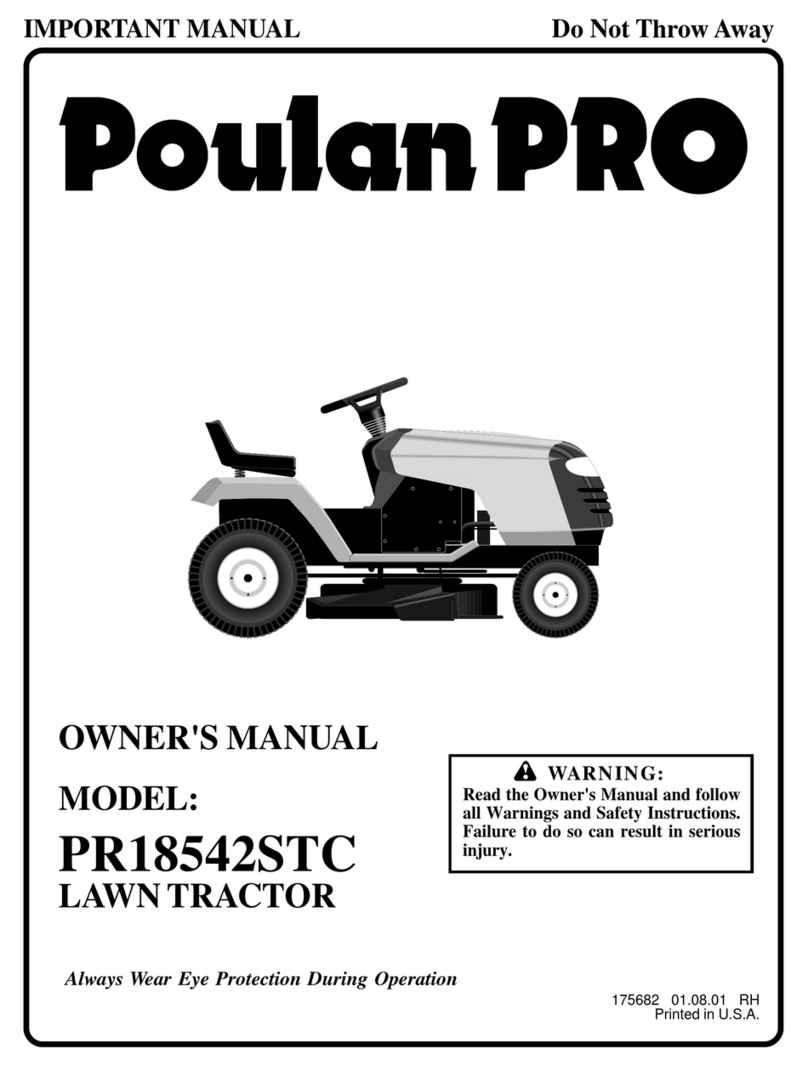
Poulan Pro
Poulan Pro PR18542STC owner's manual
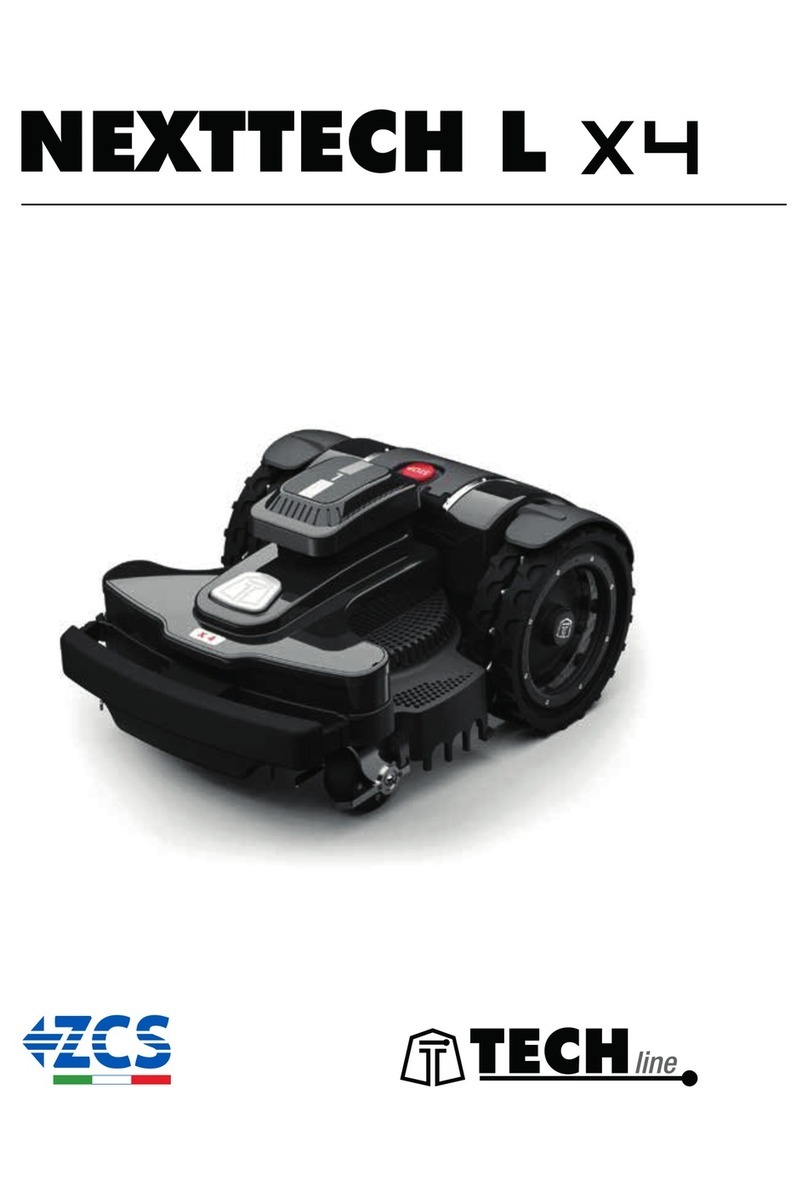
ZCS
ZCS TECHline NEXTTECH L X4 Original instructions

Textron
Textron Ransomes Jacobsen Super Certes 51 Safety, operation and maintenance manual
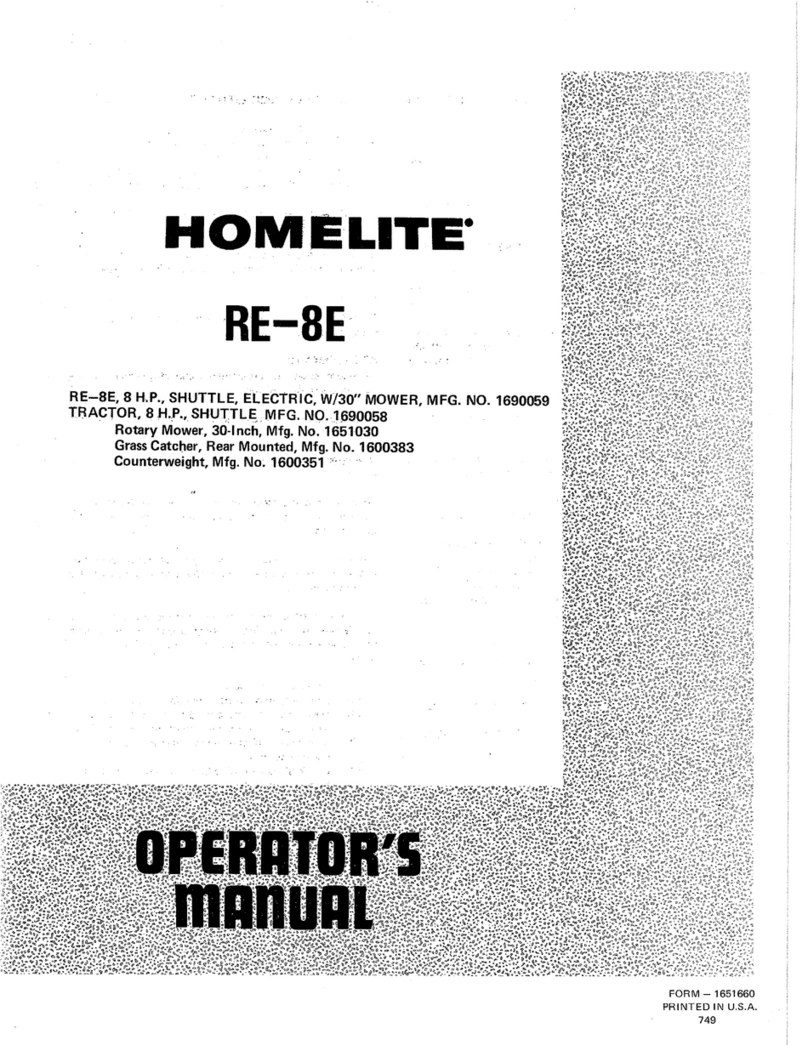
Homelite
Homelite 1600383 Operator's manual

Murray
Murray 309001x18A Instruction book

Craftsman
Craftsman 917.271743 owner's manual
